Identifying medicinal plants is like discovering nature’s pharmacy. With over 250,000 species known for their health benefits, these plants have been used in traditional healing for centuries. They contain bioactive compounds that can aid in various ailments, from reducing inflammation to boosting energy. Understanding their traditional uses and safety is essential as you explore their potential. There’s a lot more to uncover, including modern applications and the future of these plants in healthcare.
Key Takeaways
- Medicinal plants have been utilized for thousands of years, documented in ancient texts and traditional healing practices across cultures.
- Key bioactive compounds like alkaloids, flavonoids, and terpenoids in plants provide various health benefits, including analgesic and anti-inflammatory effects.
- Ethnopharmacology highlights the importance of indigenous knowledge in discovering and utilizing medicinal plants for modern pharmaceuticals.
- Various extraction methods affect the quality and efficacy of bioactive compounds, influencing their therapeutic potential in health applications.
- The rise of plant-based therapies reflects growing consumer demand for natural remedies, promoting investment in herbal medicine and holistic health solutions.
The Role of Medicinal Plants in Traditional Healing
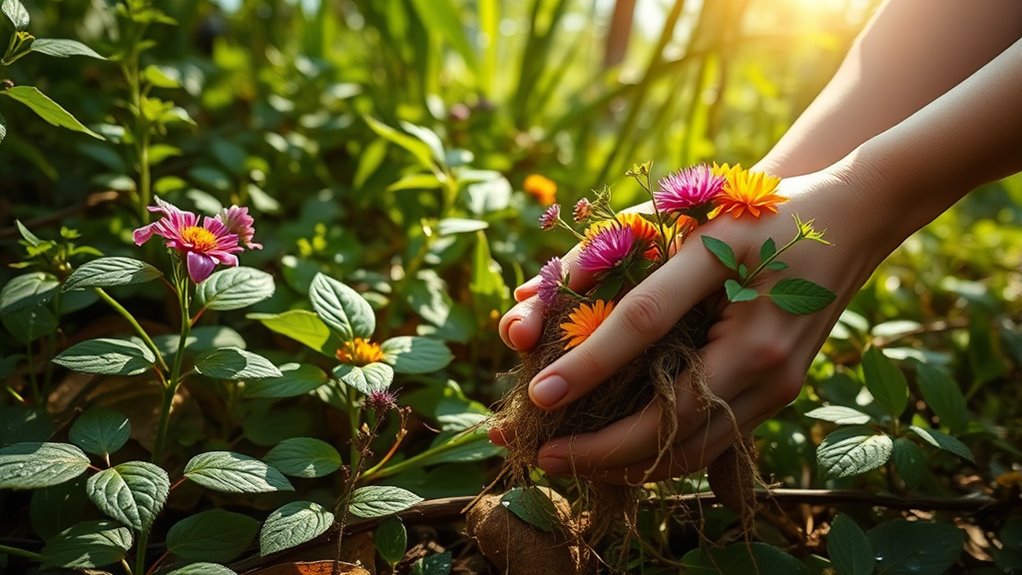
Medicinal plants have played an essential role in traditional healing practices for thousands of years, as countless cultures have turned to nature for remedies. You’ll find that these plants possess remarkable medicinal properties, which ancient texts like the Vedas and the Bible highlight. Chia seeds, for example, were recognized for their medicinal properties alongside nutritional benefits by ancient civilizations. Additionally, the use of holistic approaches in practices like Traditional Indian Medicine (TIM) emphasizes the interconnectedness of body and mind in health and healing. Herbal teas, such as turmeric tea, are often utilized for their anti-inflammatory properties, showcasing the relevance of these plants in modern wellness. Incorporating seeds like chia can also enhance overall nutritional density in traditional diets, providing valuable omega-3s.
Ethnobotany reveals how traditional cultures have identified over 50,000 flowering plants for their healing benefits. Practices like Traditional Indian Medicine (TIM) and Traditional Chinese Medicine (TCM) emphasize personalized treatments that leverage the holistic advantages of these plants, focusing on restoring balance in the body. With 250,000–350,000 plant species known to contain medicinal compounds, ongoing research continues to uncover crucial treatments, including artemisinin from Artemisia annua, which transformed malaria therapy. The cultural exchange between traditional healing practices and modern medicine can further enhance our understanding of these valuable resources.
Traditional cultures have harnessed over 50,000 flowering plants, offering personalized healing through holistic practices like TIM and TCM.
Embracing this knowledge can enrich your understanding of nature’s pharmacy.
Historical Significance of Medicinal Plants
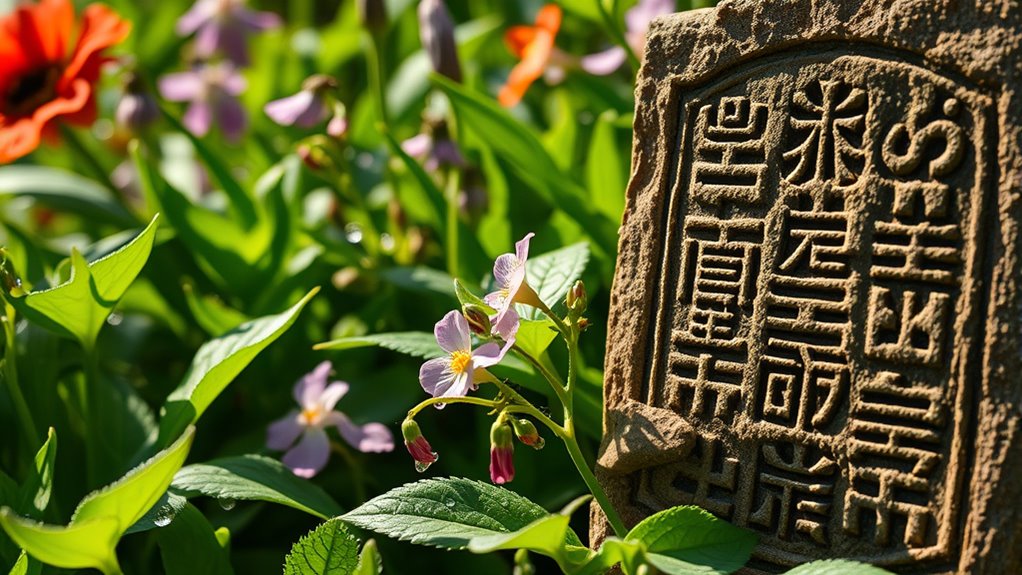
Throughout history, cultures around the world have relied on plants for healing, weaving them into the very fabric of their medicinal practices. Ancient texts like the Vedas, Bible, and Qur’an document the use of medicinal plants, showcasing their significance in traditional healing. The systematic study of these plants emerged in the nineteenth century, driven by chemistry advancements that revealed their therapeutic properties. Despite the vast array of 422,000 plant species, only 50,000 to 80,000 flowering plants are utilized medicinally today, underscoring a historical reliance on select species. In modern times, the work of apiculturists has highlighted the importance of bee products, such as honey, which have also been recognized for their medicinal benefits.
Indigenous cultures employed plants like the Cinchona tree for malaria long before modern science recognized their benefits. Today, the rise of plant-based health products reflects the ongoing importance of medicinal plants in wellness. Understanding advance directives can enhance the integration of traditional healing practices into modern healthcare. Additionally, the increasing focus on Environmental, Social, and Governance factors is influencing the development of sustainable practices in the cultivation of these medicinal plants.
Key Bioactive Compounds in Medicinal Plants

When you explore medicinal plants, you’ll encounter a range of bioactive compounds that offer impressive health benefits.
From alkaloids to flavonoids, each compound plays a unique role in promoting wellness and treating various conditions. For instance, many medicinal plants contain natural antioxidants that can further support overall health and well-being. Additionally, a balanced diet rich in fruits and vegetables can enhance the effectiveness of these bioactive compounds in promoting healing. Furthermore, essential oils derived from medicinal plants can provide additional therapeutic effects, enhancing their healing properties. Understanding these compounds and their extraction methods can enhance your appreciation for the healing power of nature. Moreover, incorporating unique homemade fruit juice recipes can provide a delicious way to enjoy the benefits of these bioactive compounds. For example, making papaya juice can be a tasty way to harness the health benefits of this nutrient-rich fruit.
Active Compounds Overview
Bioactive compounds in plants play an essential role in their therapeutic benefits, and understanding these compounds can enhance your appreciation of their medicinal potential.
Alkaloids, found in plants like opium poppy and belladonna, offer analgesic and antimalarial effects, making them crucial in modern medicine. Additionally, some plants, such as chia seeds, are recognized for their health benefits, which include promoting heart health and aiding digestion. The use of high-quality equipment in the preparation of herbal remedies can further enhance their efficacy. The importance of investing in health cannot be overstated, as it often leads to better long-term outcomes. Moreover, plants like coffee that contain antioxidants have been shown to combat oxidative stress, further supporting their medicinal value.
Flavonoids, abundant in fruits and vegetables, boast antioxidant properties linked to reduced inflammation and chronic disease risk.
Terpenoids, like those in peppermint and eucalyptus, provide antimicrobial and anti-inflammatory effects, which bolster their use in herbal remedies.
Finally, phenolic acids found in herbs such as rosemary and thyme combat oxidative stress and may help prevent aging-related diseases. These key bioactive compounds highlight the importance of medicinal plants in holistic health approaches. Additionally, understanding nail art techniques can enhance your creativity and expression through the beauty of nature-inspired designs.
Health Benefits Explained
Medicinal plants offer a wealth of health benefits thanks to their rich array of bioactive compounds.
These natural remedies, like chamomile, contain flavonoids such as apigenin, known for calming anxiety and promoting sleep. Additionally, certain essential oils like lavender oil can further enhance relaxation and improve sleep quality.
Ginseng, another powerhouse, features ginsenosides that can enhance energy, boost immunity, and improve cognitive function. Incorporating chia seeds into your diet can also offer numerous health advantages, such as being high in omega-3 fatty acids and fiber, which can aid in weight loss efforts. Additionally, chia seeds are known for their optimal growth conditions, which include full sun exposure and well-drained soil.
Curcumin, found in turmeric, showcases impressive anti-inflammatory and antioxidant properties, making it beneficial for arthritis and cardiovascular conditions.
Additionally, the Cinchona tree provides quinine, an alkaloid that effectively treats malaria.
Extraction Methods Discussed
Several effective extraction methods can draw out the key bioactive compounds from medicinal plants, each tailored to specific types of phytochemicals. Solvent extraction uses organic solvents like ethanol and methanol to dissolve and separate natural compounds, effectively targeting a wide range of phytochemicals. Essential oils for aromatherapy can also be obtained through solvent extraction, offering diverse therapeutic benefits. Recent studies have shown that sound therapy can enhance the effectiveness of these compounds in promoting emotional well-being.
On the other hand, steam distillation is popular for obtaining essential oils, where steam passes through plant material, vaporizing volatile compounds for collection. Finally, cold pressing is mainly used for citrus fruits, mechanically pressing the peels to release oils while preserving their aromatic qualities. The efficiency of these extraction methods greatly impacts the yield and quality of the bioactive compounds, making your choice of method vital for maximizing therapeutic potential in medicinal plants. Additionally, essential oils for toothache relief can be effectively obtained through steam distillation, ensuring the retention of their therapeutic properties.
Exploring Ethnopharmacology and Its Contributions
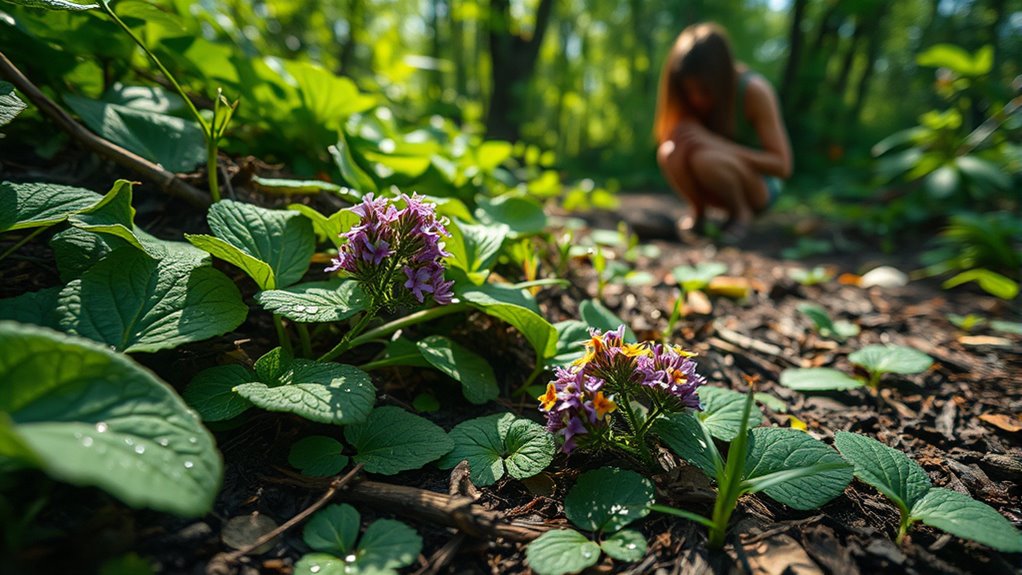
As you explore the fascinating world of ethnopharmacology, you’ll discover how this field uncovers the rich tapestry of traditional medicinal plants and their pharmacological properties.
By blending insights from botany, chemistry, pharmacology, and anthropology, ethnopharmacology enhances our understanding of natural remedies used by various cultures. Ethnobotanical studies reveal potential new drug sources, emphasizing the significance of indigenous knowledge in modern drug discovery.
Recent research highlights over 350 plant species recognized for their potential cancer treatment properties, showcasing the therapeutic value of these natural resources.
Collaborating with indigenous communities is essential, as it bridges traditional wisdom with contemporary scientific advancements, ultimately leading to a more thorough understanding of medicinal plants and their indispensable contributions to health and healing.
Traditional Uses of Medicinal Plants Across Cultures

When you think about traditional uses of medicinal plants, it’s fascinating to see how different cultures have relied on indigenous healing practices.
These plants often hold deep cultural significance, serving not just as remedies but as symbols of heritage and wisdom.
Indigenous Healing Practices
Indigenous healing practices have long relied on the rich knowledge of medicinal plants, passed down through generations and deeply rooted in cultural traditions.
You’ll find that these practices vary widely across cultures, with Traditional Indian Medicine and Traditional Chinese Medicine focusing on personalized healing through diverse plant applications.
For instance, the Cinchona tree has been a crucial source of quinine for Amazonian tribes in malaria treatment long before modern science acknowledged its benefits.
Scientific research confirms that around 250,000 to 350,000 plant species contain medicinal compounds, underscoring the significance of these indigenous healing practices.
Furthermore, many contemporary pharmaceuticals, like artemisinin from sweet wormwood, trace their origins to traditional remedies, illustrating the enduring connection between ancient wisdom and modern medicine.
Cultural Significance of Plants
Medicinal plants hold immense cultural significance across various societies, where their traditional uses reflect a deep understanding of nature’s healing properties. Ancient texts like the Vedas, Bible, and Qur’an highlight the therapeutic practices surrounding these plants.
For example, the Cinchona tree, cherished by Amazonian tribes for treating malaria, showcases indigenous knowledge in plant medicine. Traditional Indian Medicine (TIM) and Traditional Chinese Medicine (TCM) demonstrate how cultures tailor treatments to individual needs, using specific plants to restore balance.
Similarly, groups like the Akha tribe in Thailand reveal a rich diversity of plant-based remedies. Today, the cultural significance of plants continues to influence drug discovery, bridging ancient wisdom with modern healthcare practices, ensuring that traditional knowledge remains relevant.
Modern Applications and Research on Medicinal Plants
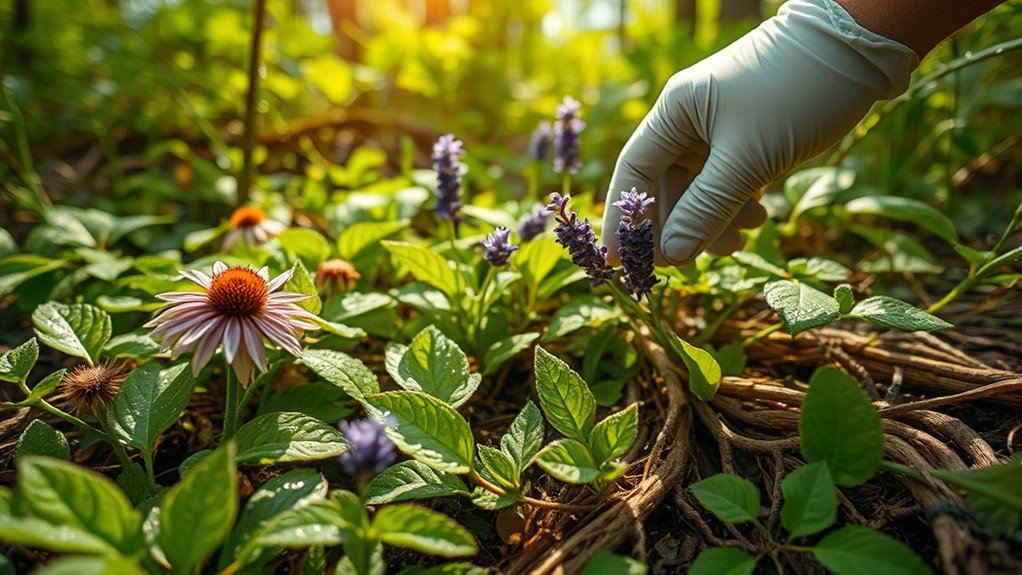
As researchers explore deeper into the world of plants, they’ve uncovered approximately 350 species with promising applications in cancer treatment, highlighting the immense therapeutic potential these natural resources hold.
Ethnobotanical studies increasingly emphasize traditional knowledge, linking indigenous practices to new drug discoveries. You’ll find that advanced technologies, like machine learning, analyze vast datasets to reveal the medicinal properties of plants, paving the way for novel pharmacological breakthroughs.
Ethnobotanical research bridges traditional wisdom and modern technology, unlocking new medicinal potential within the plant kingdom.
The fusion of traditional herbal practices and modern science has validated ancient remedies, such as artemisinin from Artemisia annua, transforming malaria treatment.
Ongoing research in ethnopharmacology focuses on polypharmacology, targeting multiple pathways to tackle complex non-infectious diseases with plant-derived compounds, showcasing the dynamic future of medicinal plants in healthcare.
The Importance of Biodiversity in Medicinal Plant Research
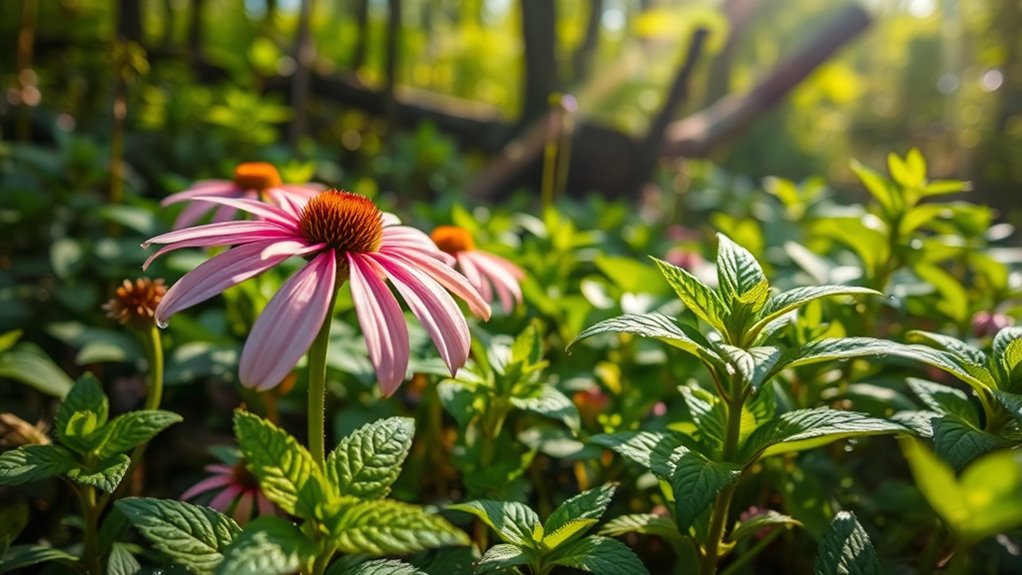
Biodiversity plays an essential role in medicinal plant research, offering a rich genetic pool from which new therapeutic compounds can emerge.
With around 50,000 to 80,000 flowering plant species recognized for their medicinal properties, conserving diverse ecosystems is vital for future drug discoveries.
Ethnobotanical studies highlight that traditional knowledge of these plants is closely tied to regional biodiversity, underscoring the importance of protecting local flora to maintain cultural heritage and health practices.
Research shows that 250,000 to 350,000 plant species contain medicinal compounds, demonstrating biodiversity’s significant role in finding effective treatments.
However, habitat destruction and climate change threaten these resources, emphasizing the need for sustainable practices in conservation and research to safeguard medicinal plants for future generations.
Safety and Risks Associated With Herbal Remedies

Though herbal remedies are often seen as safe alternatives to conventional medicine, it’s crucial to approach them with caution. Many people assume that natural means safe, but some plants, like comfrey, contain harmful substances that can pose serious health risks, including liver damage.
Additionally, certain Ayurvedic products have been found to harbor dangerous levels of heavy metals, raising significant safety concerns. The FDA’s GRAS status for culinary herbs highlights the need for regulatory oversight.
To mitigate risks, you must monitor the quality of herbal medicines since improper harvesting and processing can introduce toxins. Always research the specific properties and potential side effects of each plant to guarantee informed usage and protect your health.
The Future of Medicinal Plants in Healthcare
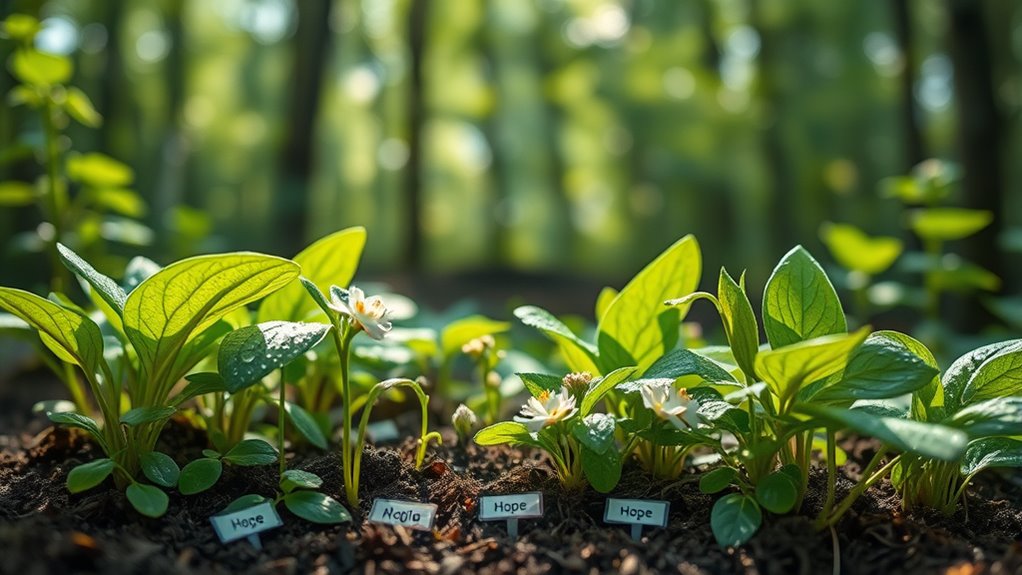
With ongoing research revealing over 350 plant species that could potentially treat cancer and other diseases, the future of medicinal plants in healthcare looks bright.
You’ll find that collaboration between traditional healers and modern scientists is essential for effective treatments.
Here are some key developments shaping this future:
- Advances in machine learning help identify novel medicinal compounds.
- Ethnobotanical studies bridge ancient wisdom with modern applications.
- Growing interest in polypharmacology promotes holistic approaches to disease management.
- Consumer demand for natural remedies drives investment in plant-based healthcare.
As these factors converge, medicinal plants are poised to play a vital role in developing innovative therapies, paving the way for a healthier tomorrow.
Frequently Asked Questions
How to Identify Medicinal Plants?
To identify medicinal plants, start by observing key features like leaf shape, flower color, and growth habits.
Use field guides or apps that show images and descriptions to help you recognize them in nature.
Pay attention to their specific habitats, as many thrive in particular environments.
Learn from local knowledge and consider joining workshops or foraging classes led by experienced herbalists for practical experience in safely identifying and harvesting these plants.
What Are the Primary Methods of Classifying Medicinal Plants?
While you might think classifying medicinal plants is straightforward, it’s actually quite complex.
You’ve got botanical classification, which sorts them by family and species, and ethnobotanical classification, which dives into cultural significance.
Then there’s pharmacological classification, focusing on therapeutic effects, and morphological classification, which considers physical traits.
Finally, chemical classification groups them by active compounds.
Each method reveals a different layer of understanding, showcasing the rich tapestry of nature’s remedies.
What Are the 10 Medicinal Plants?
You might want to contemplate these ten medicinal plants: chamomile for anxiety relief, ginseng for energy boosts, and aloe vera for healing skin irritations.
Echinacea can support your immune system, while lavender helps improve sleep quality.
Other notable mentions include peppermint for digestive health, ginger for nausea, turmeric for its anti-inflammatory properties, garlic for heart health, and holy basil for stress reduction.
Each plant offers unique benefits to enhance your well-being.
What Is the Difference Between a Medicinal Plant and a Medicinal Herb?
So, you think all plants are just here to sit pretty, huh? Well, think again! A medicinal plant includes all those green wonders—roots, bark, and seeds—while a medicinal herb is like the cool kid in school, only referring to the leafy parts.
Conclusion
As you explore the fascinating world of medicinal plants, you’ll discover that over 80% of the world’s population relies on traditional medicine for their primary healthcare needs. This statistic highlights the vital role these plants play in global health. By understanding their historical significance and the bioactive compounds they contain, you can appreciate their potential in modern medicine. Embracing the wealth of knowledge surrounding these natural remedies can lead to innovative healthcare solutions for the future.










